5
Settling In
Successful applicants for the earlier courses at Portsea were required to report to the Railway Transport Officer at their capital city interstate railway station to board trains for a dreary journey to Melbourne, as a sitting passenger with only alcohol and occasional stops at sleazy railway refreshment rooms to break the tedium. From the Spencer Street Station they were bussed to Southern Command Personnel Depot at Royal Park and after a cheerless overnight stint in corrugated iron huts, buses took them the 90 km down the Mornington Peninsula to Portsea and their waiting mentors at the Officer Cadet School. To those who had previous army service this transition to a new station was merely routine, arriving hung over from travel fatigue and cheerless imbibing; for others it was a strange and numbing experience; for all it was a relief to alight into such a beautiful setting.
The first course to arrive was a mixed group comprising 23 regular non-commissioned officers, 28 from the citizen forces and 21 without military service other than some school cadets. Their age range, from 18 to 22, averaged 20 years. A reception committee of staff members set about impressing what was expected of them, forming them up and marching them from the start, followed by a bewildering round of issues of clothing, settling in and opening talks by commandant and instructors. For the seasoned soldiers this was all fairly normal procedure, but the uninitiated were struck with an unimaginable pressure in coming to grips with so much which was new, by its volume overwhelming, and all requiring immediate comprehension and compliance. With the lights turned out at 10, and equipment still to be prepared, illegal lights under the blankets were the only way to get brass and footwear polished, rifles cleaned, equipment assembled, and later on to complete set reading or other preparation for the next day’s work (1).
Arrivals – Portsea July 1959
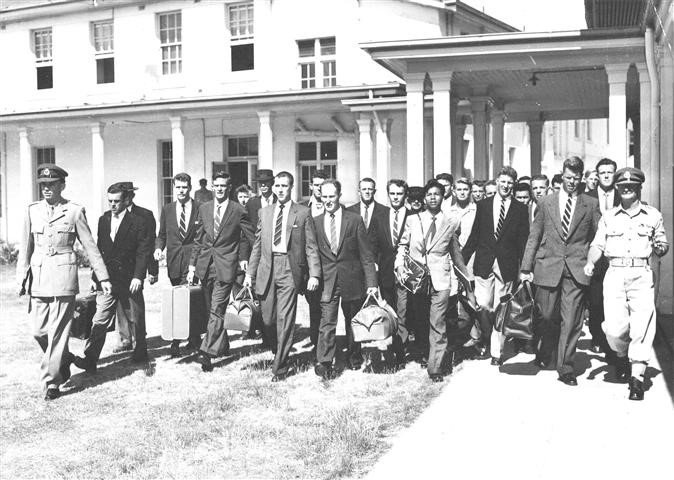
Entrants were advised to arrive ‘dressed in neat civilian attire’, perceptions of what constituted such attire varied at different times, reflecting community norms, as illustrated between the group here and the following one in 1984.
The early approach of immediately marching and doubling arrivals to their fate was replaced by a more humane one. Here adjutant Capt J.C. Harding and RSM C.R. Hockings lead them as a group to distribute them to their accommodation blocks, there to be fostered by their senior class mentors.
It was at that stage that their problems began, with endless pressure which made life a misery and confused an already confused situation, especially for those without prior service.
Photo: R.L. Bricknell
This routine was varied but slightly. When air travel became more normal, the rendezvous was still the railway station, air travellers arriving by bus from Melbourne airport, coordinated to eliminate the depressing stopover at the personnel depot by direct movement to Portsea; and those with private cars followed in convoy. With a senior class available and waiting as reception, they could then take over and settle in their protégées, the father and son system providing a senior classman who was likely to be interested in getting his junior set in good order, especially in the period when punishments awarded for poor turnout or defects in room tidiness were visited on the father.
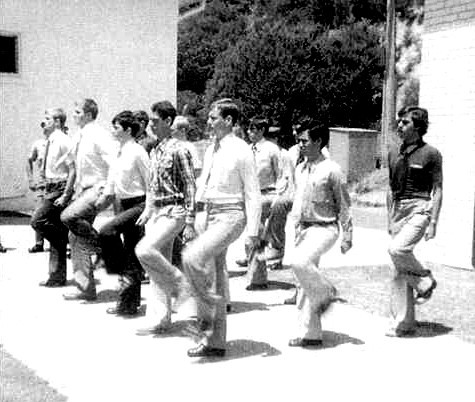
Still dressed in their civilian clothes after collecting their clothing issues, and before getting a regulation haircut, entrants were given some early drill instruction by their section commander, a tradition in the army well predating OCS.
Terminated in 1969, it became fashionable again in later years, leading to a decision to isolate new arrivals in a tented camp on Jarman Field for two weeks under the tutelage of the assistant instructors as the only sure way of inducting vulnerable youths into army life the easy way. As for the not-so-vulnerable service entrants up to 27 years of age, it relieved them of being chivvied by once-vulnerable youths wearing two stripes.
RMC Archives
This potentially sound system was, however, prone to breakdown when individuals or classes felt the urge to pass on, in magnified form, what had happened to them to their junior class: the result was impromptu drill sessions and harassment from day one, spoiling any chance that the newboys could settle in easily, so this was changed as part of a deliberate liberalisation policy in 1969 where the father-son system was discontinued, and harassment was prohibited. This transferred responsibility to cadets’ section commanders, who simply claimed their charges from the multitude assembled in the quadrangle outside the mess and took them to their rooms where senior classmen were available to assist them in sorting out and preparing their rooms and equipment. Although this worked while it was still novel and tightly supervised, backsliding seemed to come on an inevitable cycle, probably depending on the contemporary gang mentality, and the old ways of junior class training reemerged in varying degrees of virulence. The final solution in 1983 was that of inducting the new entrants into a separate tented camp under tutelage of the staff warrant officer and NCO instructors, at the end of which time they joined the COC in their permanent accommodation better able to cope with both the routine and to some degree with their seniors (2).
Arrivals – 1983
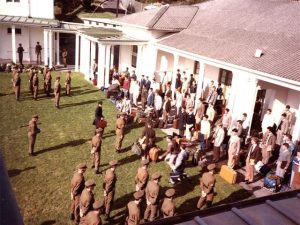
The old hurry-up days were supplanted from 1969 by having clothing issues in the rooms, beds ready made up and a more progressive exposure to the routine and discipline.
A further step in smoothing out the induction shock was one of easing the cadets in as individuals. Assembling in the PMC’s lawn, senior class sponsors claimed protegees as their names were called out by RSM WO1 B.A. Hassell and led them away to their living quarters.
This was theoretically designed to give the new juniors a smooth entry into a fast paced daily routine. It worked only as long as the senior class made it that way: in some periods even before the liberalisation era it did, and others later on it reverted to good old fashioned harassment.
OCS Scrapbook 1983
Daily Routine
Daily life officially began with reveille and lasted until lights out. Unofficially this was extended by early morning and late evening preparation with hurricane lamps and blankets at windows, or when mains power was connected, a single bar electric radiator under the bed. Thereafter it was a succession of parades for everything: defaulters, breakfast, morning lectures, lunch, afternoon lectures, sport, dinner and evening activities. With a usual five minutes between activities and different orders of dress and equipment, activity was intense both inside and outside the actual working periods five days a week, with Saturday reserved for such morning activities as grounds improvement and afternoon organised sport; Sundays allowed an extra hour in bed then were free apart from church parades and religious services, offering a chance for washing, ironing and preparation and cleaning of equipment. And outside normal working hours the senior class was able to add some useful assistance and some not so useful diversions by deliberate time wasting and such harassments as questioning and unofficial drill tuition (3).
Extra Curricular Activities
The routine for normal working weeks in 1954 shown in Table 2 is representative of the type of programme which applied, however this was varied in some later periods of the School’s existence. The term parade had several connotations: one sense was that it was precisely that, a parade assembling people for a purpose. Reveille parade meant stripping beds, standing outside the door to be checked as present by section commanders who reported to the platoon sergeant who then advised the orderly NCO so that a parade state could be made, the roll books marked, catering numbers determined and those reporting sick identified. Similarly a defaulters parade was just that, with those undergoing punishment falling in in the prescribed order of dress and undergoing inspection, drill and possibly more punishment awards as a result. Another sense was the technical one of appearing at a place of parade, absence from which was an offence army-wide: so while an instructional parade might involve falling in to be checked for presence and be marched to the venue, the content might well be sitting in a classroom for lectures or tutorials, firing a weapons practice on the range, or running to Point Nepean and back in battle order on a physical efficiency test. A mess parade might again require falling in, a head count and listening to announcements, but its effect was to get people into the mess to eat and drink; a study parade was simply being present in one’s room studying.
Instructional parades were 40-45 minutes duration according to an army standard based on research into concentration and retention levels amongst students. As it was the practice to mix types of instruction for variety it meant that students had the benefit of five minutes to get to their rooms and change from one order of dress to the next, then get to their next place of parade. With changes from drill order to physical training order to field orders there was plenty of scope for lightning fast switches, which gave rise to the practice of ‘leaps’, that is rapid changing of orders of dress.
The intensity of these parades was eased periodically as the course lengthened and various attempts were made to lighten the burden, but ever-present pressures to accomplish more and include more soon subverted this. In 1960 commandant Col S.T.G. Coleman standardised all periods at 40 minutes, and with nine periods up to 1630 hours it was possible to provide cadets with some free time by eliminating Saturday morning work, but it was reinstated the following term when it became apparent that the late start for sport in the winter was impractical, and with no sacrifices to be made in course content, the last period was transferred to sport and their content substituted for Saturday leisure. Another attempt in 1969 under the liberalisation programme abandoned lights out and reveille, and gave students shopping leave 1530-1800 hours Mondays and on Saturday mornings to Melbourne, weekend leave after sport on Saturday afternoons through Sunday evening, with leave for social functions weekdays freely available; married cadets living locally were encouraged to go to their homes whenever there were no activities at the School (4).
This proved more liberal than either the less dedicated of the cadets could handle and the expanding School curriculum could allow. Various small adjustments tightened up the whole considerably, ending up with reveille reinstated and a quarter of an hour earlier, first instructional parade at 0745 with an extra one finishing at 1730, sport being now counted as such. Saturday morning work was reincarnated with a busy six periods followed by all-afternoon sport, shopping leave being restricted to Friday night and, the criminality of cadets having apparently increased, defaulters parades now held six times on Sundays, thrice on others. The sole tradeoff for these additional benefits was the official listing of morning tea each day, at which the habit of Toc racing arose, where classes vied to consume all the available fare at the expense of later arrivals (5).
‘Toc’
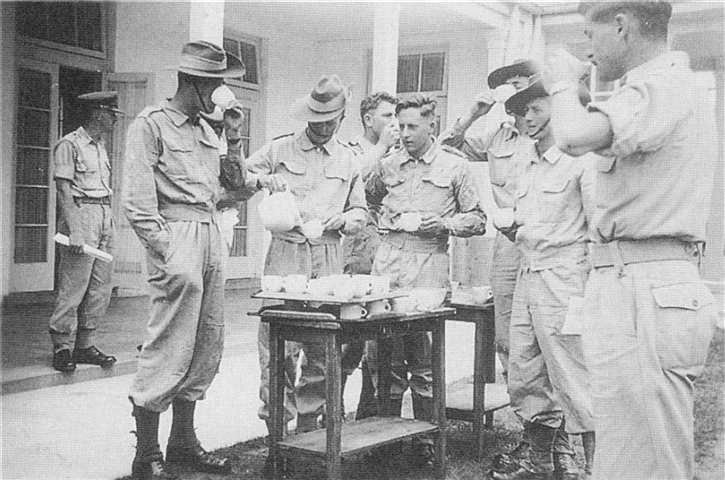
When students were in the area, morning tea was served in a 15 minute mid-morning break between periods. Here members of the course take it in a gentlemanly fashion, not always the case in later years: identified are R.J. Johnson, G.P. Warland and G.D. Burgess.
Toc was an expression (from the then phonetic alphabet for T) imported with the first group of exRMC cadets to enter Portsea; it was later Mornos, Smoko or all three. Toc racing was the name for different classes attempting to get in first and demolish the goodies, the residue being fed to some of the fattest seagulls known to man. This demolition process became known as scorched Toc, a habit discouraged as anti-social.
In some eras, politeness in waiting for a turn was the norm particularly visiting other establishments, but old habits resurfaced from time to time, usually the product of large classes when mob psychology replaced normal standards.
Photo: I.C. Teague
It was remarkable that so much could be packed into a day, a week, a term, a year; the course having grown from 22 weeks to 44, and finally 46. The proponents of two years being necessary to provide a balanced education for a career officer did not reckon on the ingenuity of the commandants and chief instructors at Portsea, who managed to cram so much into each day and indeed into each period in the day, with the additional fillip of 24-hour days on field training. Compared with undergraduate life at a civil tertiary institution the OCS year easily matched two years. It was an unfortunate facet of army diffidence or apartheid, or perhaps both, that no effort was made to award real tertiary qualifications at service colleges, including even staff colleges whose military qualifications were expressed in small letters. Defence Secretary Bunting, on being pressed for support to solve the earlier comparative lag in service pay, expressed his contempt for service officers who generally did not have tertiary qualifications, and in a community where degrees were becoming common place, albeit many of the mickey mouse variety, it did a great disservice to the graduates to let them pass out without a recognisable qualification appropriate to their professional status and achievement. The American practice of tertiary accreditation for military studies showed the way to providing professionals with widely recognised qualifications which had became socially necessary. With the successful achievements gained on their course, award of an undergraduate diploma in defence studies from OCS would have been very appropriate.
Extra Activities
Building roads
Campus 1962

A good preparation for the afternoon’s competitive sport, Saturday mornings added to physical fitness of the students, supervised by engineer instructor Capt B. W. Lake who had convinced commandant Coleman that the effort would be ‘character building and good experience in military engineering’.
OCS Scrapbook 1962
Filling leisure time
Campus July 1972
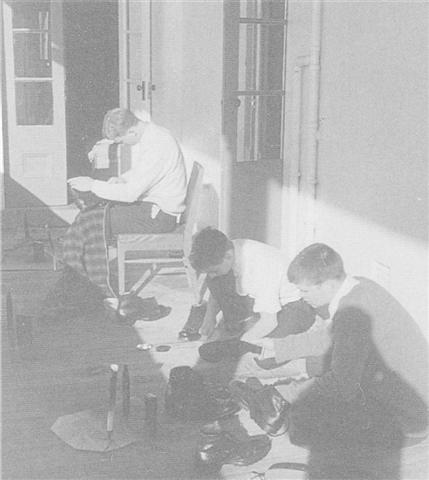
G.S. Knight, R.J. Morris, B.H. Catt hard at work bogging: cleaning gear occupied a good part of leisure time, or the absence of it ensured that defaulters parades would do the same.
Photo: A.J. Ferguson
Firefighting
Point Nepean Reserve, 1960
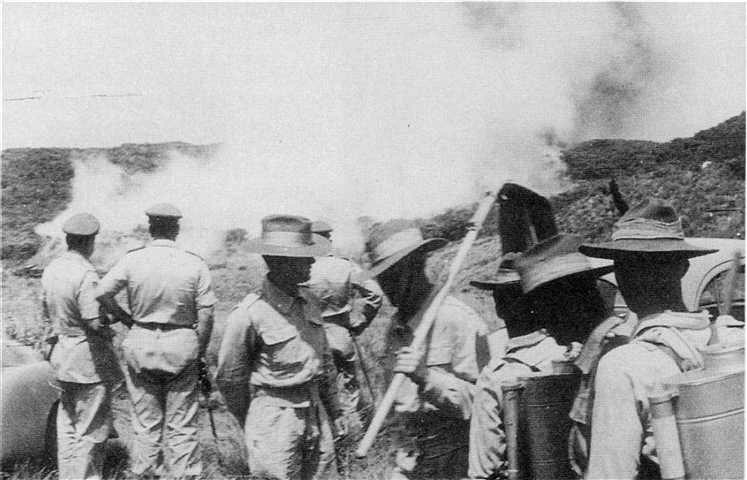
Closer settlement had brought a dense titree scrub which casual entrants such as fishermen or picnickers could ignite, as could School weapon practices. This fire burnt 200 hectares at Wilson’s Folly before cadets and staff controlled it.
Local residents valued the scrub highly and were apt to protest at any fires, knowing there had been some deliberate burning off in the School’s early days.
Having cleared the necessary spaces, OCS also valued the remaining vegetation for both training and ecological value. Army officers were natural environmentalists, protecting training areas long before it became fashionable on the patios.
OCS Scrapbook 1960
Living Conditions
While a cadet’s room was a place of rest, it was also his study and in addition the potential source of grief. Rooms had to be maintained in inspection condition during parade hours, which meant also during sport and study hours. Beds had to be stripped at reveille, so there was no chance of making it before then to get a flying start, so in the next hour had to be fitted a shower, shave, dressing, bedmaking, sweeping and dusting, and for those in need or so invited, sick and defaulters parades: either of the latter two imposed such a loss of time that rooms were sure to be below par, and if inspected the source of award of more punishment. Similar problems arose during the day with changes from one order of dress to another in short order, with the room again having to be left in inspection order (6).
What was unusual to service and civilian entrants alike was the rigid layout of clothing and equipment in the rooms and, with no doors on the clothes cupboards of the original two accommodation blocks, any discrepancies were easily noted. The two new blocks of the early 1960s were designed in a more modem style and built of materials more amenable to cleaning, although carpeting did not become a standard amenity until 1974. But the outriders had different problems: those in the overflow wing at OTU Scheyville in 1972-3 lived in huts which had been built as a post-war migrant centre, designed to the familiar spartan style barely above the standard of the temporary army camps of two world wars. When this closed and no further development was forthcoming for Portsea, the decontamination bath houses were converted into rooms for an extra section, so saving the contingency plans of doubling up in rooms, use of bunks and impressing the table tennis room or a projected use of Mt Martha House 40 km away. Doubling up had been a disturbing feature of the School until No 2 Hospital was released for the 1955 overlapping classes, and this was beginning to occur again as the 1970s intakes brought a peak residency of 176, beyond the 160 total for which the 1963 and 1965 blocks were built, and was averted only by the expediency mentioned above: the prospect of the Tri-Service Academy had paralysed any permanent works programmes for officer cadet facilities, even though the common wisdom was that this would be a post-1980 reality (7).
Doubling up in Rooms – 1972
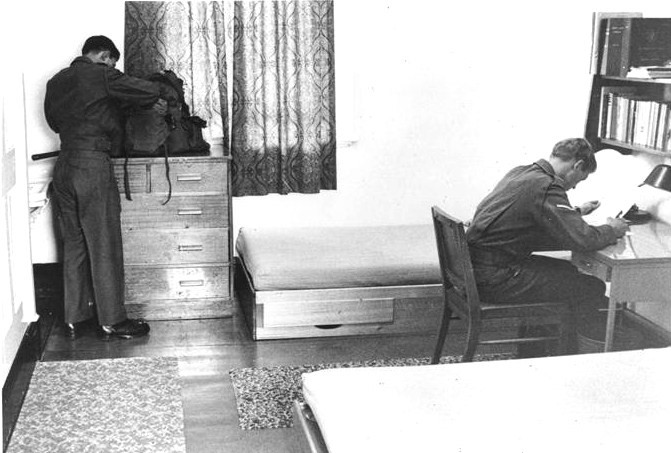
If the room was simply a bedroom, sharing would have been merely an inconvenience in lack of privacy. But it was used for study and preparation of a range of clothes and equipment, the physical area being insufficient for two, even with the necessary extra wardrobes being put in passageways.
For those on whom this affliction was visited it made for complications not only in physical space available but also in studying, relaxing and sleeping. Coordinating two different patterns of activity and behaviour in one small area for an extended time was not conducive of effective study, and placed extra strains on behaviour and relationships.
Australian Archives
Although the bed space problem was solved by a reduction in the forecast student population from 240 to 160, the congestion also carried over to training office and recreational facilities. Part of the cadet room problem had been caused through additional instructors being given offices upstairs in the No 2 Block, so when the hoped for extra block faded, these were moved out to the 1919 huts until a temporary office block could be built by 21st Construction Squadron from Puckapunyal. Six ex-Victorian Education Department temporary classrooms were also procured, a better solution than reuse of the 1919 huts, and the impending vacation by Department of Health allowed release of more buildings so that a reasonable spatial solution was arrived at, even if the quality left something to be desired (8).
Even when buildings were built or released from Quarantine, there seemed to be inordinate delays in making them habitable. From the initial years of no mains power or adequate hot water for both students and staff, through the agonisingly slow upgrading of 19th century accommodation and facilities after permanence of tenure was assured, other setbacks appeared. The second of the new cadet accommodation blocks was handed over in April 1965 with wiring for heaters but no heaters, and after the early 1970s all additions had to be temporary, a source of frustration to commandants and discomfort for the users (9).
For married staff and cadets there was a grimmer outlook. While married cadets were encouraged to bring their families with them, no provision whatsoever was made for married quarters so they had to rent on the local market. Trying to get reasonable standard houses in a seaside resort on a corporal’s pay was a testing exercise even with a rental supplement available after the course was extended, and until 1969 the rare weekends that were their only official opportunity to go home made living difficult for the families. For the staff, married accommodation was always in short supply, starting with three quarters, with 15 by 1955, 48 in 1968 and 53 in 1972; there was always going to be a long waiting list with over an hundred potential applicants. Not that the standard of quarter was something to fight for, as a Quartermaster General said in 1971 of the improved housing standards recently approved by Treasury ‘there are no mansions in this lot’. In fact for many staff and cadets it was desirable that married quarters were not available as better standard houses could be rented on the local economy with rental assistance. So the returns on the housing lists for 1976 show a waiting list of 53 (including 14 cadets) as being non-active, that is they did not wish to be allotted a quarter, preferring to remain in rented houses, and remained on the waiting list simply to qualify for continuing temporary rental allowance; similar figures persisted in succeeding years (10).
With closure of the remaining quarantine facilities in 1978, the handover of the last buildings gave OCS the lock stock and barrel which had been the objective from early days. The last few houses and buildings provided some extra storage space and married quarters and, for the commandant, a very ample residence in the Bungalow. By this stage everyone was decently housed in some form or another. While there is always room for improvement, such finesses had to be forgone with relocation certain and works support limited to maintaining existing buildings in livable condition. The quarters were comfortable, messes and clubs had been upgraded to modern standards, sporting facilities were good and the picturesque location had been enhanced by ongoing plantings of trees and shrubs ever since occupancy had begun. Commandants had long played on the theme that the School should be accommodated at a standard appropriate to its national and international status, and by the late 1970s it had gone as close to that as it was likely to get (11).
Rooms
Room Layout
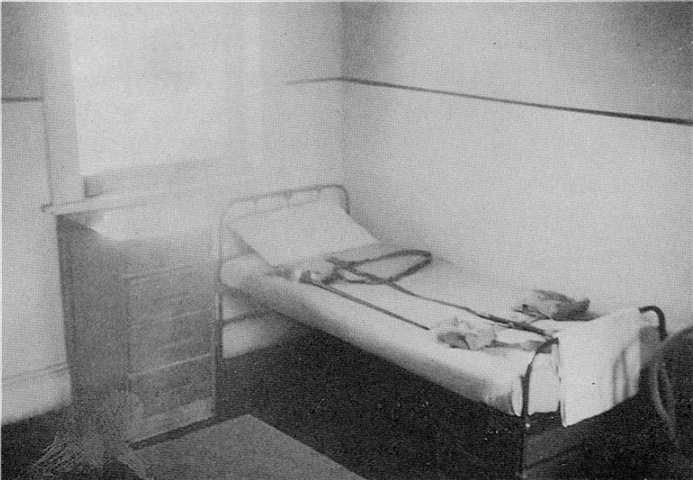
There was some method in the madness of the standard room layout: its functional use that all clothing and equipment was readily available, ready to wear and in a predictable place. But it went well beyond the functional, giving staff with a greater penchant for petty detail than breadth of thought the opportunity to impress themselves on the minds of the students.
The other side of the coin was the natural tendency for bachelor slovenliness in living areas, a topic well appreciated by parents with young and not so young sons. In setting a minimum standard for experienced evaders, it was difficult to define anything other than a maximum.
Photo: I.C. Teague
Cupboard layout
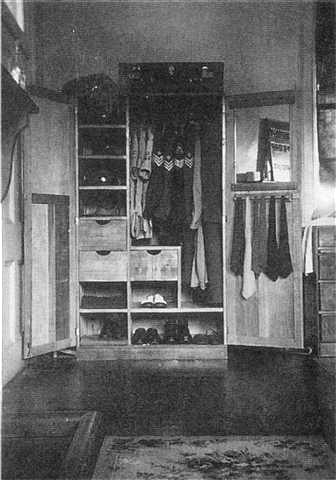
Strict guidelines applied to all disposition of clothing. Piles of small clothes were folded to fit the size of a page of unit standing orders.
Those able to work it could possess duplicated sets, those for show and those for use. A cadet’s sole refuge lay in a locked metal cabin trunk which was not inspected, or a friendly car boot, but capacity and the requirement to have a minimum of items on display placed limits on its efficacy.
Photo: I.C. Teague
A Sunday Room
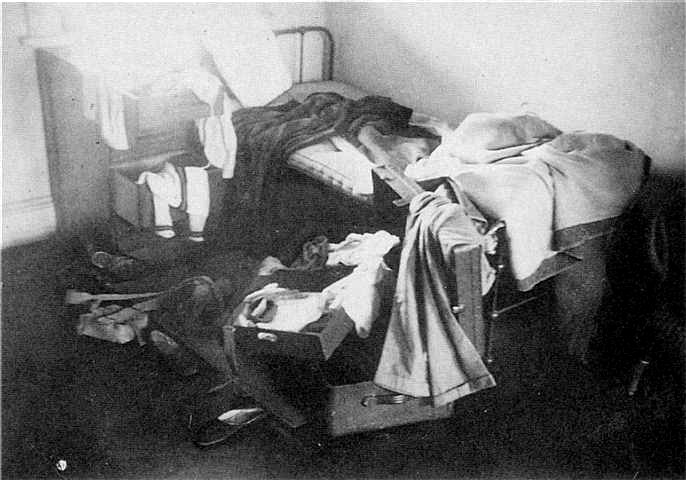
The luxury of Sundays without room inspections was variously celebrated, this example demonstrating the necessity for strict standards on other days.
Rooms also came to a similar condition when a cadet attracted the adverse attention of his fellows or seniors. A thorough ‘binning’ meant hours of work restoring the neatness, acting as either a salutary punishment or the satisfaction of a sadistic sense of humour.
A particularly subtle but cruel example in binning rooms involved not disarray but the exchange of items between cadets of different sizes without disturbing the layout, so that the results became felt over a period of time at the most awkward times of rapid dress changes.
Photo: I.C. Teague
Training Activities
The level of activity arising from the daily routine was, by other tertiary institution standards, intense. Attempts to make space for free study periods were short lived as either weaknesses in some areas or additional material reclaimed any open spaces, and the value of discontinuous one or two 40 minute study periods was dubious, usually used as a welcome break in a busy day rather than the opportunity to buckling down to serious study. Whatever elegant terms and concepts may have come into use as theorists moved in to the ancillary staff of the instructional wings, the technique used was basically the time honoured one of force feeding in order to inject the employment-specific information and skills considered necessary for a career army officer. While RMC might have the extra three years to provide a broad general education, OCS was strongly targetted, and indeed many entrants preferred the OCS course for that specific reason, not because they lacked academic ability although that was one of the original reasons for establishing the School: the December 1973 graduating class included cadets with a PhD, BSc, BEc, B Tech Engr, 59 at Leaving or better level and only 10 sub-leaving who were service entrants, but assessed as having the ability to reach leaving level given the opportunity (12). The selection board had also not accepted on other grounds many other applicants who had a tertiary education, so the nature of the course was certainly not dictated by any shortage of capacity in the students.
Perhaps it was the great variation in the scope and conduct of the course which caused the most difficulties. While providing a day in which a variety of subjects each confined to a single period and delivered at a strapping pace could give a stimulus which banished sameness and boredom, such techniques are best suited to specific knowledge and skill related work rather than assimilation of concepts and consequent reasoning. There was also the other factor of students regarding some subjects as peripheral to the core theme of military proficiency, so incipient failure was a constant problem, remedial work being the only alternative to an unacceptable termination rate.
Assessment of student performance became a major industry, complicated by the variety and scope of subjects covered and the slippery one of leadership assessment, passing at which was central to a cadet’s graduation. It was also a source of ongoing concern to those who were under warning as a result of considerations by the Board of Studies or its predecessor, the threat of failure dogging some throughout most of their course. In an ideal state the non-motivated should have recognised that they were in the wrong institution and left as some did; the remainder, motivated and selected for having the right ability, should have cruised through a menu of well presented instruction to an untroubled graduation. However such is not human nature. Those who put in only sufficient to achieve 51 percent can miscalculate; others fall foul of particular instructors who influence their colleagues in the bad dog syndrome; and still others were selection mistakes. While guidance officers were appointed very early in the School’s operation, and they at least could give fair early warning and provide sympathetic assistance, it was up to the individual to meet the demands of the system, or if it was cast against him, to try to beat it. Many succeeded, 23 percent failed (13).
One of the real hurdles was to inculcate a learning ethos in students who had chosen OCS as the path to a life and career of action. Selection boards had to be careful in assessing the motivation of applicants that they were not simply dropping out of other activities with some prospect of their doing the same when the going got tough on the course. But unlike current advertisements couched at seducing entrants to the service colleges based on naked greed and self interest, OCS had strong input into recruiting advertising material, making sure that applicants were sought from those motivated to the rigours and rewards of military life and command. Those selected, after their initial basic training, then had to face an increasing array of military and quasi-military academic subjects, which were somewhat at odds with the motivation of the majority who had not responded to a call to train as an administrative officer or a staff officer; indeed many had specifically left such work to come to Portsea. Excellence in instruction, which was the target of the faculty and one which was generally achieved, could deliver the information but could not force understanding or retention. While some were natural learners, others had to be cajoled and eventually faced with the threat of removal.
Post-Board of Studies activities were a necessary part of keeping the less willing up to speed and so getting them through the course. And it had to be a worrying situation where future leaders of the army had to be pushed to achievement rather than being natural achievers. This was of course part of commandant Cape’s moulding process, and for some it succeeded during the year. But it became obvious that some of the late developers had no more than gone with the pace at Portsea, developing their own high standards in their own time in their later service. For these it was worthwhile to accept the risk; for others they remained marginal through the time they spent in the army, and left to find success or further lack of it in other fields.
Firing the GPMG – Point Nepean Reserve 1962
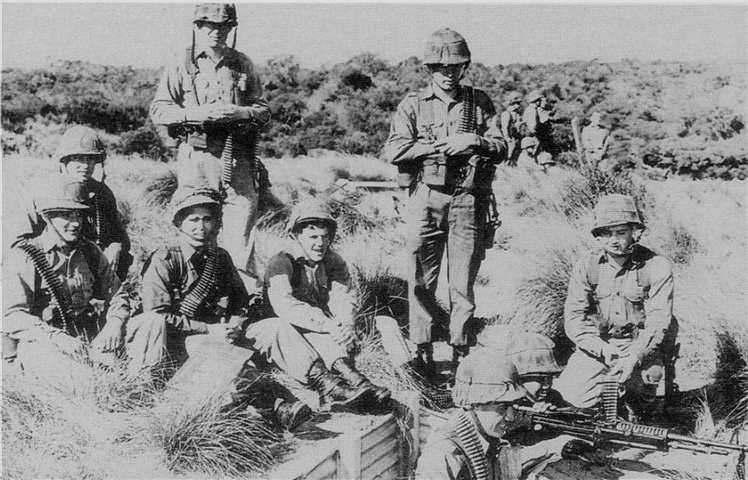
The Nepean Defence Reserve provided an optimum close training area with a variety of ranges for infantry weapons.
The cadets were now trained on a new generation of weapons and new equipment – self loading rifle, general purpose machine gun and US pattern webbing and helmets were introduced in the early 1960s in a much overdue change to post-World War 2 equipment.
OCS Scrapbook 1960
Field training of various natures provided a substantial part of the syllabus. Ranging from elementary weapons skills and rangework, through map reading and navigation, fieldcraft and minor tactics to full field exercises and battle simulation, it was at the heart of a basic objective of the course to produce a trained infantry platoon commander. Initially all was conducted in the Point Nepean Defence Reserve which provided the attraction of time-saving proximity, but eventually camps and exercises were spread far afield in state forests in the Healesville, Seymour and Yarram areas. These exercises gave the cadets the opportunity to plan and conduct much of the activity themselves as well as practising their field and operational skills, but it also became a focal point in assessing leadership qualities and performance away from the false relationships of the cadet rank system in the School routine. Given a series of junior command and leadership appointments and tasks in company and platoon exercises, the students were at last put in the position which they were training for, not of being goaded over obstacle courses and physical fitness tests by instructors, but having to undertake arduous activity and still have the reserves to think, command and look after others (14). They were the making of many, and the breaking of others.
Putting in on the Point Run – Point Nepan 1972
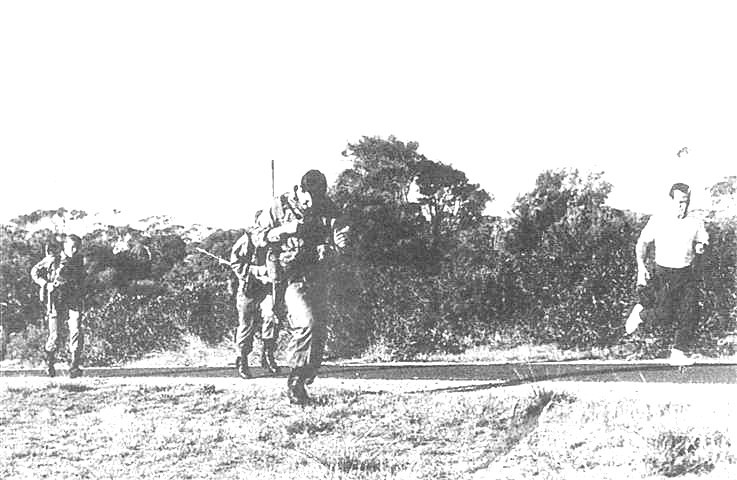
The physical fitness regime included much running, in all orders of dress; here S. Flynn and A.E. Cremer struggle on the run to Point Nepean and back.
When it got hardest, there was usually a staff member to provide encouragement. It is interesting that the latter usually seemed to be in light running order while cadets struggled under packs and weapon loads. Astute cadets learned from this that leadership involved sharing soldiers’ hardships rather than taking the easy way in a ‘do as I say’ relationship.
The endless miles or kilometres pounded in old fashioned sandshoes and boots no doubt did a great deal of lasting damage to feet and lower limbs of cadets, carried on into their subsequent service. It was not until the 1970s that more modern joggers were permitted, but running in boots remained.
OCS Scrapbook 1972
Other activities filled in or supplemented the academic and field training. Training in etiquette was a standard element to bring all students up to a uniform standard of table manners and instil social ability as best as can be done in such an elusive topic.
Mess dinner – Campus 1959

Mess etiquette was a basic subject: the cadets mess was run on the lines of an officers mess as far as this could be achieved. After basic tuition in table manners in the early part of a course, dining nights with staff members in attendance were held to accustom students to formal dining and the format of the type of regimental dinner they could expect in their later service. It also coincidentally provided them with a special meal and alcoholic drinks in a more civilised way than was gained in forays to hostelries.
These were extended to mixed nights with officers’ wives and cadets’ guests to provide further social experience.
Attending nearest are: A. Sheridan, D.R. Lawrence, M.G. Holton, R.V. Behan, Izidain, B.G. Le Dan and B.M. Reid.
Photo: D.J. McLachlan
There was also a strong element of religious training through character guidance courses undergone by all, and church services at which attendance was strongly encouraged. Physical training under a team of specialised instructors aimed at initiating basic fitness, improving strength and coordination and remedying individual physical weaknesses. It was applied with the same robustness which characterised other activities, the scramble track behind the gymnasium up a hill through the ti-tree presenting both a test for classes and another unlisted summary punishment available for individuals who attracted the ire of instructors. Sport was held to be an integral part of the development of physical and team skills, so it was a scheduled part of activities after what might be considered the end of the day’s work. It also appeared on the programme for Saturday afternoons, so that which many regarded as recreation became part of their training. For the cadets it was indeed a time of recreation, marking the end of five and a half days of near frenetic activity, after which they looked forward to an evening of relaxation, unless of course they were under punishment.
Swimming Sports – Campus 1971
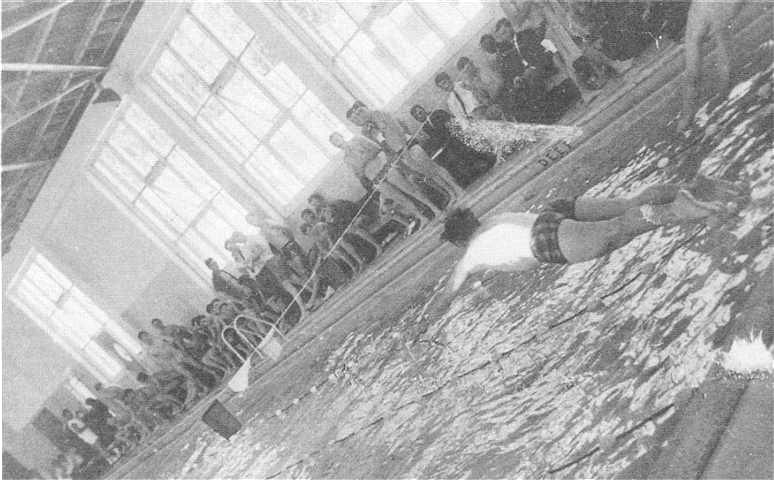
A popular sport given a suitable venue and warm water, OCS was never endowed with its own pool, making do for training and competitions with hiring pools at Rosebud or Melbourne, or using those at Flinders or other colleges.
Competitions ranged from inter-platoon and inter-company, through the annual trophy against RAAF Academy Point Cook, to the later Inter-College Swimming Meeting against all the other service colleges, held in rotation at the various campuses each year.
Always a strong seasonal sport at Portsea, the School was a consistent performer in these various external competitions.
OCS Scrapbook 1971
In theory the courses conducted in the OCS wing at Scheyville were the same as those at the Portsea campus. In reality there was a difference, even though the Block Syllabus used was the same. As an obvious economy measure, where the OTU courses were undertaking components compatible with the OCS ones, which virtually meant the junior class term, the OCS wing attended their lectures and participated in their field exercises. But there was something of a problem in that the compressed nature of the 22-week OTU course meant that everything was done at a faster pace, with ‘a general rush in the air’. While this was natural enough for the OTU short course cadets as had been the case with the first six OCS courses, it meant that the OCS Wing cadets had to sustain that pace for a full year, while their colleagues at Portsea retained the benefits of the steadier pace which had replaced the frenetic activity of the original short courses.
OCS Wing – Scheyville 1973
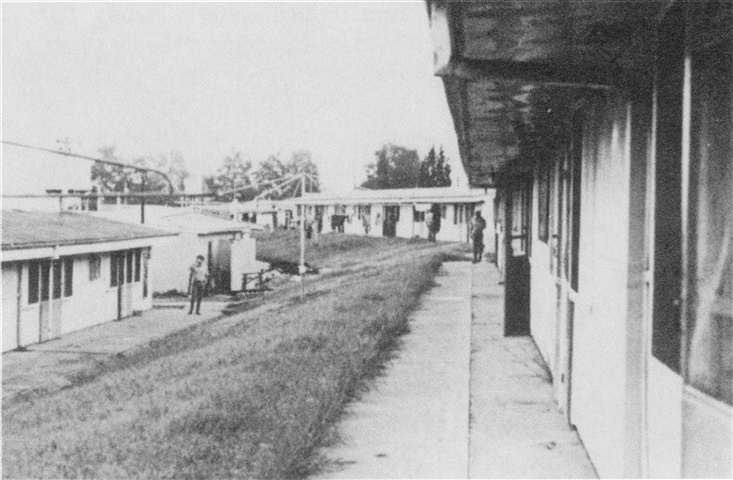
An ex-migrant reception centre for the postwar waves of immigrants from Europe, the OTU buildings were of a quite different calibre to those of Portsea, though both greatly needed maintenance.
There was always a problem for OTU in keeping up the spirits of OCS cadets who saw overlapping OTU classes graduating every three months, while they themselves waited for a year. The other minus was attempting to integrate the two syllabuses. While students saw themselves as just part of the overall course production line, it required an ongoing effort to effect coordination of instructional work between the two streams.
OCS Journal Jun 1973
One beneficial effect of the six month course cycle they were involved in was a big fish in little pool effect: their junior class apprenticeship lasted only three months, with the remainder as senior class with its rank, privileges and exemptions, but the downside lay in the morale buster of seeing two contemporary classes of OTU graduate before them. Then there were the limited privileges reflecting those of the OCS short courses – leave restricted to Saturday nights and Sundays, although the fact of no married cadets being included in the Scheyville wing prevented that problem re-arising. There was no outside sporting competition, again appropriate to the OTU environment but a strong minus to be limited to internal activities for a full year; and they were exposed to the rigours of computer-processed assessment, not yet in vogue at Portsea. The initial feeling of being thrust into this environment dedicated to the efficient processing of numbers in short order was ‘why me?’ – for several initial weeks there was a feeling of being dumped there while the more privileged on the other side of the fence enjoyed the imagined greener pastures of Portsea. Their connection with OCS was following its curriculum, staff visits and joining their fellows at Portsea for the final ten days of instruction and graduation activities, though the last course of the wing in November 1973 arrived earlier in time to undergo the mixed benefit of participating in the final exercise as well (15).
Discipline
If there was a real unfaltering fetish at Portsea it was in the administration of discipline. Starting on the basis that it is necessary to exercise self-discipline before expecting it of subordinates, the system was based on rigid standards, infringements of which attracted punishment, on the presumption that its infliction would bring home to offenders the need to exercise self-discipline. A wide array of punishment systems existed over the period of the Schools existence. One technique for the senior class was awarding merit points at the start of term, with each infringement carrying a loss of points or demerits, loss of all points resulting in loss of rank: E.J. Ellis made history by being the first CSM to lose all points and have to do extra drill over a prank of taping a tear gas capsule to the Commandant’s radiator which misfired by catching the visiting Burmese military attache; as he managed to avoid losing his rank the commandant must have seen some humour in the situation. Another system was an accumulation of demerit points to 10 or 20 in a week resulting in an automatic charge from which punishment would be determined. Punishments consisted of extra drill parades, confinement to barracks, stoppage of leave or show parades. While RMC used a similar range, these were legalised by having its own special regulations under the Defence Act. A 1965 Army Headquarters proposal for special regulations for all colleges failed to materialise so OCS had none, being effectively just another unit of the army operating under Australian Military Regulations which provided for punishments by formal charge, and only those proscribed, which did not include all those awarded to cadets (16).
Morning SOL Train – Campus 1981
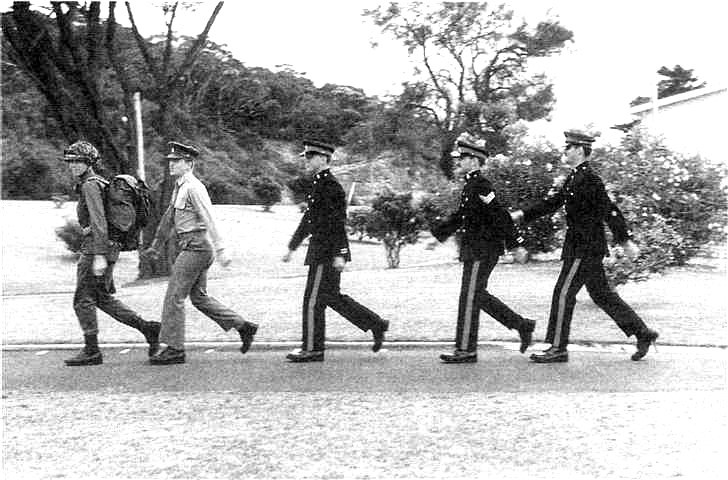
So called as the line of miscreants filing down the hill towards the parade area reminded someone of a train. On marching off from the assembly point, the victims were known to respond with choo-choos while it was safe to do so.
A several-times daily event, it was more than SOL, a defaulters parade for those under sentence for petty crimes awarded EDs, SOL or CB, plus those detected with imperfect equipment given ‘show parade’, bringing the rectified article along for inspection: here the first is on CB, the next Show Parade, and three SOL. Identified are LA. Shepherd, R.B. Bartetzko, P.J. Howden, M.H. Beattie.
A fault or infringement on defaulters brought more punishment; and if this was avoided, time lost in preparing a room to inspection order, and getting ready for the day’s activities was difficult to catch up.
Photo: D.N. Thornton
Allotment of punishments could be by summary award or resulting from a formal charge, with a variety of staff and cadet NCOs authorised to make awards (17). Implementation of these draconian limits could make the life of a cadet nearly intolerable: three months SOL or 28 days CB in an already hard environment were enormous penalties, and although they might be rarely and sparingly used, the lower level ones of the company commander were more commonplace. Similarly summary awards were couched at a ridiculous level. To imagine that a commandant or chief instructor would want to stride around the School handing out 34 days SOL for infringements observed is ludicrous. But the ability to award two extra drills was a potent weapon to other staff who regarded one ED as beneath them. Punishments tended to repeat themselves as they disrupted a cadet’s activity and laid him open to further awards. Australian Military Regulations allowed summary awards by formal charge only, the summary category being a lesser punishment allowed without giving the accused the option of electing trial by court martial; the Portsea variety was simply illegal, being justified as a ‘training model’ (18). Recipients of repeated doses of such training saw it otherwise, particularly where the punishments were out of proportion to the crime. Such a system was necessary to inculcate high standards in young men, many of whom started by showing a remarkable lack of personal standards and self discipline, but the problem was the same as the internal one within the COC: how to stop a system which was designed to be used constructively with a light hand from becoming oppressive.
The effective means of implementing these punishments was through defaulters parades conducted twice or more often daily. Those under sentence fell in at the accommodation blocks and filed down the hill to the front of Badcoe Hall, in a procession which came to be known as the SOL Train. For those on stoppage of leave it was a means of checking that they were still within bounds, but also gave the opportunity to inconvenience them by having to parade in uniform and be inspected with the potential for further punishment. Those awarded show parade similarly had to be in uniform and present the articles which had been found defective, and again were open to full inspection. Those undergoing extra drills and confinement to barracks were also inspected then given a period of drill to complete any time left over. The cadet orderly officer inspected, the cadet orderly NCO drilled, and the staff duty officer might also inspect if he chose to attend and add his bit to the punishment list (19).
Cadet sergeants and under officers were awarded SOL, others endured the rigours and hazards of EDs and CB, so there were some physical benefits in cadet rank. Punishments were recorded in the Punishment Book in which members had to enter their own sentences; it was used by the cadet orderly NCO to check attendance at parades. The RSM ruled off the punishment book and added up the offences for each cadet before board of studies meetings and OCdt P.D. Colquhoun did one out of 10 before realising what had given him the debit. Some cadets collected punishments with gay abandon, others managed to avoid it by some miracle until the end of their course when, if this became known, there might be attempts to rectify the situation, countered by defenders protecting him. The class of June 1982 for its reunion at Portsea in 1992 published a punishments scoreboard which saw five members headed by I.W. Coombe awarded an A pass with over 30, eleven a B for 15 and over, fourteen a C for 9 or better, and twentyfour failures below that, M.B. Matthews at the bottom surviving with none whatsoever. A worse fate befell P.M. Perrin in an earlier time when his maiden escape was frustrated by RSM Hockings discovering the oversight and compulsively handing out a dozen on the second last parade (20).
All this was in a long tradition coming down from the first courses where the assistant instructors initially vied with instructor and self-appointed arbiter of standards Lt G.G. Jarman in organising extra drills. Subsequent limiting of summary power by junior instructors, replaced by cadet under officers awarding EDs and SOL added a new dimension to punishment for the junior class, but at least these were awarded in ones rather than the more fashionable multiples from some staff members, and were more observable and more controllable than some of the more subtle avenues of cadet intervention, in the words of adjutant general Maj Gen A.L. MacDonald after the 1969 RMC bastardisation furore ‘ill treatment under the guise of administration or other training’. There were two crosses for an officer cadet to bear: staff bastardry and cadet bastardisation. The School set its face against both, but both existed (21).
Discipline
Powers of Punishment
| Award | Commandant | Commanding Officer | Company Commander | Specified Staff | Cadet Under and Orderly Officers |
| Charge | |||||
| Recommended removal | Yes | Yes | |||
| Reduction in cadet rank | Yes | Yes | Yes | ||
| Confined to Barracacks (CB) | 28 days | 28 days | 14 days | ||
| Reprimand | Yes | Yes | Yes | ||
| Admonition | Yes | Yes | Yes | ||
| Stroppage of Leave (SOL) | 84 days | 84 days | 14 days | ||
| Summary Award | |||||
| Extra Drill (ED) | 2 | 2 | 2 | 2 | 1 |
| Stoppage of Leave | 34 days | 34 days | 3 days | 3 days | 1 day |
| Show Parades | Yes | Yes | Yes | Yes |
Cadet view of punishment

Mass punishment had long been discarded from the lexicon of disciplinary measures in the army, but vestiges remained.
OCS Journal June 1978
Summary Demerit Report
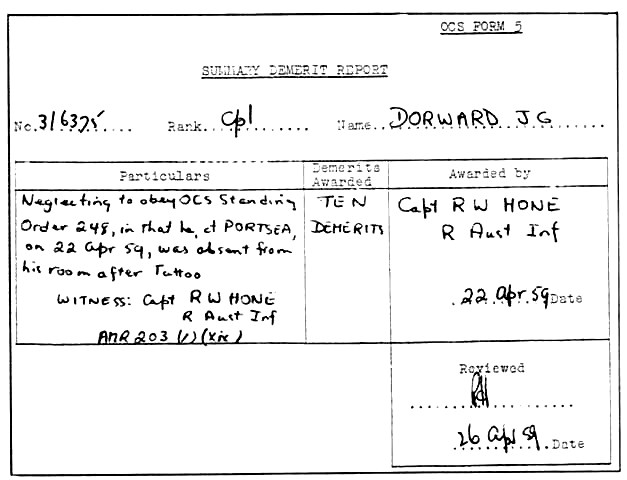
An award for an intra-unit raid: the summary award or charge had to be filled out by the offending cadet, so adding insult to the injury to follow.
OCS Scrapbook 1959
Unluckygram
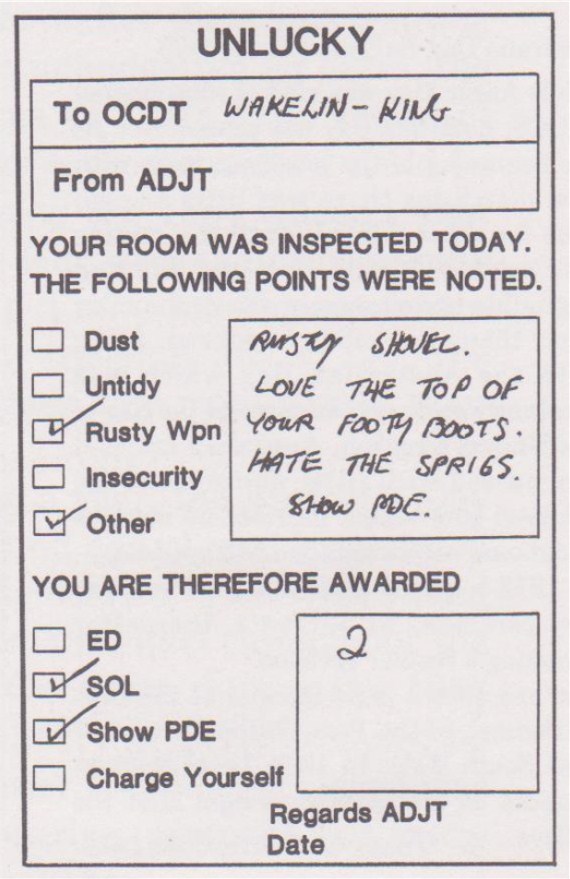
The Unluckygram, invention of an adjutant, imparted a cheery veneer to a subject totally without luck and without cheer.
Image: D.I. Grierson
Ceremonial
Drill was a standard subject. From its original purpose thousands of years old of manoeuvring fighting groups on the battlefield and marshalling the effective use of weapons, it had become largely a ceremonial performance but retained the minor tactics of Waterloo on the parade ground. However underneath all the pomp and circumstance there remained the idea that drill also taught rapid coordinated response to orders, and some aspects of it were valuable in moving groups around in good order and time. The student body certainly used the latter to regular purpose in getting to and from training activities, but the most obvious end product of these exertions at Portsea was clearly to be seen in the ceremonial parades and guards which punctuated the calendar.
For a syllabus which contained only 100-200 periods of drill and ceremonial, there was certainly a lot of it done. Much was absorbed in the initial basic training to bring the new entrants to a uniform standard of proficiency, and thereafter there was training in advanced subjects including sword and colour drill. As an unbudgeted-for extra, the general movement of cadet groups with and without arms on their daily round of instruction added to the practice, so that within a few weeks a good standard could be achieved, as was demonstrated in the single-class era during the 1954 Queen’s visit when the cadets lined the street near Melbourne Town Hall four weeks after beginning training. The extended course provided the opportunity to put on a full Queen’s birthday parade in 1955, though the lack of colours precluded any trooping, and in 1968 the colours were received on a public parade with the junior class four months into their training (22).
Australia Day – Sullivan’s Cove, 1973
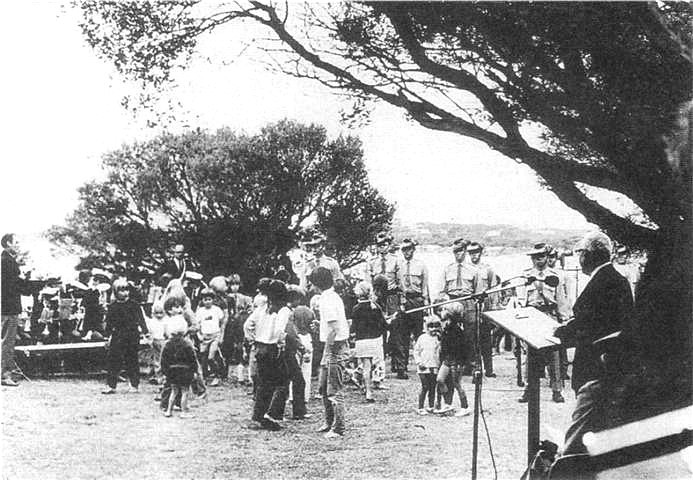
While Anzac Day was always remembered at OCS, Australia Day was passed over. At the beginning of the academic year, with new march-ins there was little enough time for other matters until the routine was settled. In addition, the day had negligible acceptance in the community other than as a holiday weekend. Along with the Australian flag which was constantly given second place to the flag of the United Kingdom, Australia’s national day passed with little notice until the Whitlam government provided an impetus to national self-recognition and symbols.
In 1972 a guard attended an Australia Day ceremony at Sorrento, thereafter becoming a regular function. The one shown is at the site of the first settlement in the Port Phillip District of New South Wales in 1803. Local children pounced on the spent cartridges after the volleys.
OCS Scrapbook 1973
It was usual to perform several ceremonial functions in a year: the Australia Day ceremony at Sorrento, an Anzac Day commemoration, mid and end of year graduation parades. Interspersed were guards of honour for visiting dignitaries, usually mounted without fuss or excessive rehearsal due to the proficiency maintained throughout the year, and such special events as the review of troops at Canberra during the 1963 Queen’s visit and 1977 Army jubilee. Drill and ceremonial very properly occupied no more than five percent of the curriculum, however the superior standard achieved was an important element of the outward symbols of soldierly bearing, personal and group pride, and public presentation of the School as a centre of excellence.
Anzac Day – OCS Memorial 1973
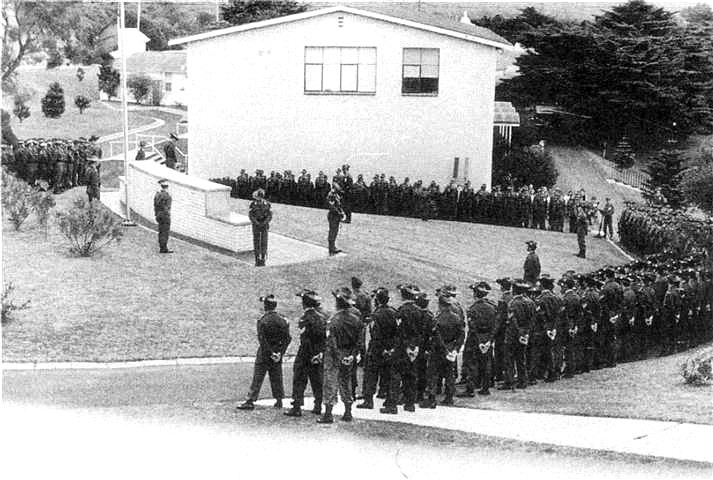
Staff and cadets joined in full turnout for a major commemoration of the traditional army Remembrance Day.
Always observed as a day of commemoration at Portsea, this turnout reflected a national revival of the Anzac tradition. Anzac Day had increasingly become a day for the RSL to march and go to reunions. For the civilian population and sadly for most serving regular and citizen soldiers, it had become another holiday. Perhaps it was a closing of the ranks of Vietnam veterans at the end of the Vietnam conflict, after the turmoil and rejection of the 1960s, that the Regular Army began participating in the day’s activities, culminating in the 1980s when units and formations treated it as a parade and joined as units in the various marches throughout the country.
OCS Scrapbook 1973
Graduation
Graduation Parade – 13 June 1980

A later custom, after the parade the graduating cadets threw their caps in the air. Not an original action, it nevertheless expressed their joy at getting through an exacting year and achieving the aim of gaining a commission in the Australian Staff Corps.
RMC Archives
The end of all courses means different things to different individuals. To those graduating from OCS it meant the end of an arduous period of mental and physical exertion and transition to a new life of authority, responsibility and action. To others it meant the abrupt collapse of their hopes of gaining a commission. It is difficult to understand how some of the late terminations could be justified, with some cadets told of their failure in the last 48 hours, their parents already en route to Portsea for their graduation. Various reasons were advanced for this, mostly lacking validity, on one occasion the School acknowledging a failure of procedures. While there was no doubt that commandants were entirely correct in refusing to graduate any officer cadet whom they believed would not make an effective officer, in a long course it was not credible that a last minute decision was useful, as anyone so marginal towards the end of a year of continuous assessment could not be a reliable performer and would therefore be unsuitable to be commissioned as an independent operator. But commandants were under pressure to minimise failure rates, so the temptation was there to stretch the final decision in the hope of passing more, with the added bonus of uncertainty keeping the general mass of the class active and interested. A late piece of common wisdom was that if you received an invitation to the commandant’s cocktail party three days before graduation you were through (23). Even that was not always true.
Graduation activities and festivities grew from an end of course parade and ball to a week in which the junior class took over the running of the COC to allow the potential graduates to settle their affairs, participate in the social round, meet relatives and guests and generally have as relaxed a run down as could be arranged or tolerated. The end product in an institution never short of paper was a 100-page instruction booklet detailing the ceremonies with a countdown from D-45. The programme included the official functions of (24):
- Graduation church parade, church service and luncheon
- Graduation drinks in the Sergeants Mess
- Graduation dinner
- Beating the retreat and graduation cocktail party
- Official luncheon – cadets not involved
- Graduation parade
- Graduation ball
- Commandant’s address and post graduation drinks in the Officers Mess
By itself this array was a formidable hurdle to surmount in five days. As well were interspersed corps drinks, golf day, ladies buffet dinner, rehearsals for the parade and ceremonies, wet weather rehearsal, private parties and family obligations. A year of sustained effort, eighteen months for some, and the objective of a commission in the Australian Regular Army was achieved. The rehearsal was over: the real world of soldiering with its pains and rewards lay ahead of them.
Graduation 1952
Source: AWM
Graduation
Graduation parade – 11 June 1965
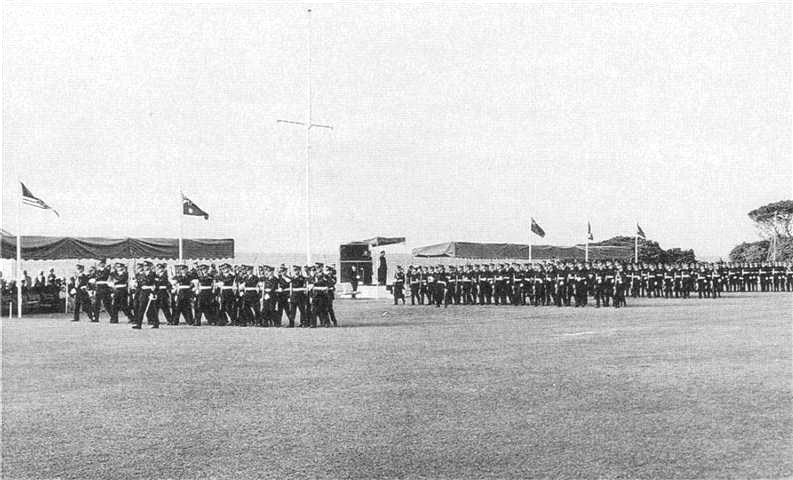
End of a long hard year, the parade marked the passing out of the surviving 76 cadets, including 10 from New Zealand and two from the Philippines. With 150 on parade, it was a marked difference from barely a third of that number at the beginning of the decade.
A feature of OCS graduations was that cadets’ guests were given pride of place in covered seating at the front of the ground, in contrast to the disgraceful situation at RMC where they were progressively moved to the side of the parade ground without cover to make way for increasing swarms of self-important guests of college, military and academic staff.
At the conclusion of the parade the cadets were presented with certificates by the reviewing officer and prepared for their graduation ball.
Photo: R.L. Sayce
Graduation certificates and prizes – 14 June 1956
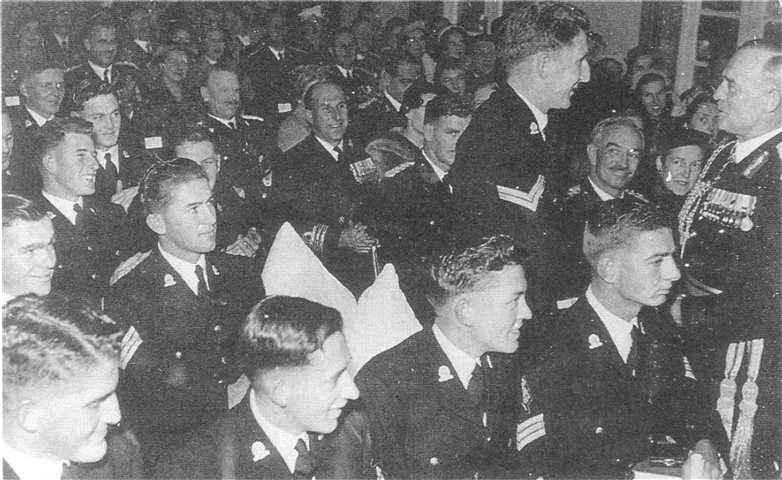
Maj Gen R.G. Pollard CBE DSO Master General of the Ordnance, later Chief of the General Staff, in the tight confines of the main lecture room presents his graduation certificate to I.G. Darlington, with staff and official guests in the background.
Identified graduates from the back:
M.A Count (December 1956) B.E.J. Johnson GE. Erickson K.M. McDonald R.G. Althaus
I. T. Stewart R.A. Brazier
P.J. Smith J.R. Wilcock J.L. Mitchell J.M. Oxenham
OCS Scrapbook 1956
Afternoon tea for the graduates and guests – 11 June 1959
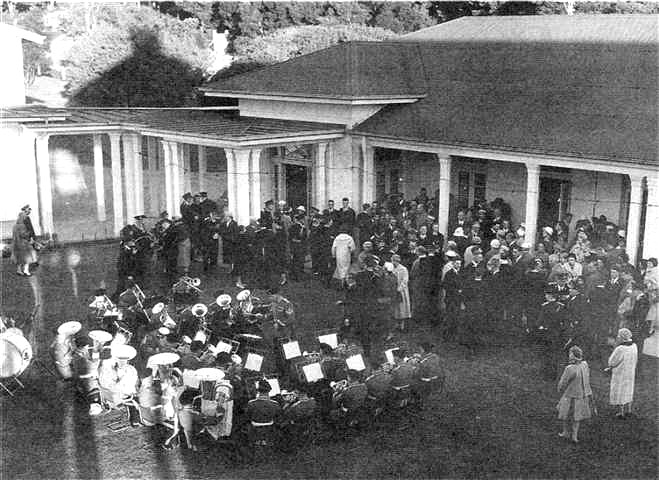
At the conclusion of the graduation parade, staff, students, guests and families gathered at the cadets’ mess for afternoon tea, with the regular performer at these ceremonies, the Southern Command Band playing a musical accompaniment after its efforts on the parade itself.
Following the tea it was preparation for the evening ball, and pre-ball parties, and some last minute packing for those not confident of their capability the following morning.
Photo: R.L. Bricknel
Graduation ball – 14 June 1956

Midnight on graduation night and mothers, wives and sweethearts pin the pips on the epaulettes of the newly commissioned officers, their prize after a year of blood, sweat and tears and for most, at least retrospectively, a lot of good memories enhanced by the blurring effect and selective recall of time and the sentimentalism of maturity. Featured are J.L. Mitchell and J.M. Oxenham
After the ceremonies relaxation was complete for the ex-cadets, until the following day of the commandant’s closing address, and their march out for leave and their first postings.
For the junior class there was leave and return for their turn at running the Corps and trying to make the next graduation ball.
OCS Scrapbook 1956
References
- AA MP897 1 1 27/32/9 of 20 December 1951; Interviews R.G. Lange et al.
- AA MP897 1 1 27/32/9 of 20 December 1951; Interviews R.G. Lange et al.
- OCS Standing Orders 1954, 1983; Interviews R.G. Lange et al; Letters J.A. Harriot, M.L. Kearn; Cameron H.T. ‘Autobiography’ ch 17.
- AA B2453/1 R723/1/1 OCS Reports December 1960, June 1961; R133/2/8 of 4 April 1970.
- OCS Standing Orders 1983.
- OCS Standing Orders 1954; Cameron ‘Autobiography’ ch 16, 17.
- OCS Standing Orders 1954; Cameron ‘Autobiography’ ch 16, 17. OCS Standing Orders 1954 Appendix E; AA B2453 R723/1/1 OCS Reports July 1970..January 1974.
- AA B245311 R130/2/2 of 9 February 1971; R723/117 of 28 January 1972; R7/2/1 of 25 September 1975; R7/1/3 of 18 February 1976.
- AA B2453/1 R723/1I1 of December 1953, June 1957, June 1960, 17 February 1971.
- AA B245311 R7/3/4 of 11 August 1959; R1I13/41 of undated 1965; 10/319 of 30 June 1963; R14/1/1 of 6 February 1976.
- eg AA B2453/1 R723/111 of 29 January 1970; R7/2/1 of 25 September 1975; R7/2/1 of 18 February 1976.
- B2453/1 R723/1/1 of 17 January 1974.
- Table 8; AA B2453/1 R441/1/1 of 16 October 1983.
- AA B2453/1 R441/1/1 of 16 October 1983.
- OCS Journal June 1972, p42-3.
- Letters E.J. Ellis; AA B245311 RI331218 of 29 September 1969; OCS Standing Orders 1984 para 106-119; AA B2453/1 729/R2/1 of 21 May 1965.
- AA B2453/1 R545/1/18 of August 1984 Punishment at OCS.
18.AA B2453/1 R545/1/18 of August 1984.
- OCS Standing Orders.
- Standing Orders; OCS Journal June 1979, p25; Letters A.A. Nicolic, P.M. Perrin.
- Interviews I. Throssell, I.G. Hands; AA B2453/1 R133/2/8 of 29 September 1969; OCS Standing Orders 1983.
- AA B2453/1 R723/1/1 of June 1954; R274//1/1 of 20 May 1968.
- AA B2453/1 R730/1/3 of 4 October 1976; Letters O.M. Eather.
- OCS Graduation Ceremonies Instructions 1984, Serial 1 para 1.
Keywords